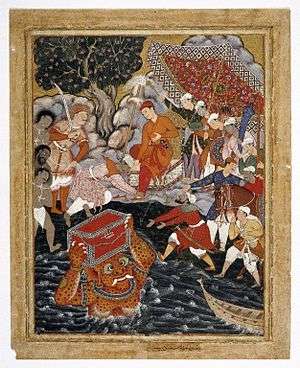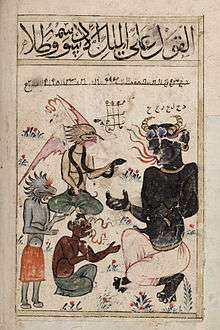Ifrit
 | |
| Grouping | Jinn |
|---|---|
| Sub grouping | Shaitan / Ghost |
| Mythology | Islam |
| Region | Middle East, South Asia[1], Southeast Asia[2] |
Ifrit, efreet, efrite, ifreet, afreet, afrite and afrit (Arabic: ʻIfrīt: عفريت, pl ʻAfārīt: عفاريت) are supernatural creatures in some Middle Eastern stories. In Islam, this term refers to the most powerful and dangerous Jinn.
Description

The Ifrits are a class of infernal djinn and also held to be a death spirit drawn to the life-force (or blood) of a murdered victim seeking revenge on the murderer.[4][5] As with ordinary djinn, an Ifrit may be either a believer or an unbeliever, good or evil,[6] but it is most often depicted as a wicked, ruthless, and evil being; a powerful Shaitan.[7] Ifrits are believed to inhabit the levels of the underworld[8] or desolated places on the surface, such as in ruins or caves.
According to Islamic sources, the Ifrit has a fiery appearance with flames leaping from his mouth. It may be a danger to people, but can be destroyed if someone recites a Du'a (Islamic prayer) near it.[9]
In folklore, they are commonly thought to take the shape of the deceased at the moment of death, or the appearance of the Shaitan. In the Islamic traditions of Cirebon, the Afarit are known as Mrekayangan, a subcategory of demons. But their origin is different from the other demons, since the Mrekayangan appear after someone died improperly, while the demons are descendants of Iblis.[10]
Etymology

The word Ifrit seems to be of Arabic origin. Traditionally, Arab philologists trace the derivation of the word to عفر (ʻafara, "to rub with dust").[11] Some Western philologists, such as Johann Jakob Hess and Karl Vollers, attribute it to Middle Persian afritan which corresponds to Modern Persian آفريدن (to create).
Islam
An Ifrit is mentioned in the Qur'an, Sura An-Naml (27:38-40):
[Solomon] said, "O assembly [of jinn], which of you will bring me her [the Queen of Sheba's] throne before they come to me in submission?" An Ifrit (strong one) from the jinn said: "I will bring it to you before you rise from your place. And verily, I am indeed strong, and trustworthy for such work." One with whom was knowledge of the Scripture said: "I will bring it to you within the twinkling of an eye!" Then when Solomon saw it placed before him, he said: "This is by the Grace of my Lord - to test me whether I am grateful or ungrateful! And whoever is grateful, truly, his gratitude is for (the good of) his own self; and whoever is ungrateful, (he is ungrateful only for the loss of his own self). Certainly, my Lord is Rich (Free of all needs), Bountiful."
According to a hadith from Bukhari, an Ifrit tried to interrupt the prayers of Muhammed. Muhammed overpowered the Ifrit and wanted to fasten him to a pillar so that everyone can see him in the morning. Then, he remembered the statement of Solomon and he dismissed the Ifrit.[12][13]
According to a narration about Muhammeds Night Journey, an Ifrit sought Muhammed with a fiery torch. To get rid of him, he asked Jibraʾil for help. Jibraʾil then taught him how to seek refuge from God, whereupon the Ifrit get away from him.[14]
An Ifrit, meeting Imam Ali, is mentioned in different Shi'i accounts. According to the Shabak community, Imam Ali became incensed against an Ifrit for his unbelieving. Consequently, he bound the Ifrit in chains. The Ifrit appealed to all prophets since Adam for his release. But no one was able to free him, until Muhammed found him and took the Ifrit to Imam Ali. He freed him on the condition that he would profess his faith for Islam.[15]
In the Qisas Al-Anbiya (Stories of the Prophets), Afarit perform the orders of Iblis to plague Job. Each of these Afarit are endowed with specific abilities such as turning into a firy storm or killing by shouting out.[16]
Arabic literature
In One Thousand and One Nights, in a tale called "The Porter and the Young Girls", there is a narrative about a prince who is attacked by pirates and takes refuge with a woodcutter. The prince finds an underground chamber in the forest leading to a beautiful woman who has been kidnapped by an Ifrit. The prince sleeps with the woman and both are attacked by the jealous Ifrit, who changes the prince into an ape. Later a princess restores the prince and fights a pitched battle with the Ifrit, who changes shape into various animals, fruit, and fire until being reduced to cinders. In the book, the word is used interchangeably with genie and the spirit is malevolent but easily tricked by the protagonist.[17]
The blind poet Al-Maʿarri mentioned in his narrations, a paradise for Afarit with "narrow straits" and "dark valleys".[18]
In early folklore, the Ifrit is said to be formed from the blood of a murder victim. Driving an unused nail into the blood was supposed to stop their formation. The creatures were reported as being able to take the form of Satan, the murder victim, or even a sandstorm.[19]
In modern popular culture
An Ifrit plays a major role as a story element in bollywood film Pari: Not a Fairytale where the lead character played by Anushka Sharma is the progeny of an Ifrit and human, due to a cult practice. The film was based on a book series called An Ember in the Ashes'.
The trading card game Magic: The Gathering has featured several "efreet" since the earliest expansion sets.[20]
Ifirt is a prominent Summon to fight with in the Final Fantasy video game series. Like their mythological counterparts, Ifrit's are spirits of fire and destruction, almost always appearing as a devilish monster that uses either fire, earth, or both to do damage to either the monster the player is fighting or as a boss against the player himself.
See also
References
- ↑ Frederick M. Smith The Self Possessed: Deity and Spirit Possession in South Asian Literature and Civilization Columbia University Press 2012 ISBN 978-0-231-51065-3 page 570
- ↑ A.G. Muhaimin The Islamic Traditions of Cirebon: Ibadat and Adat Among Javanese Muslims ANU E Press 2006 ISBN 978-1-920-94231-1 page 38
- ↑ de Lafayette, Maximillien (2017). Early & contemporary spirit artists, psychic artists, and medium painters from 5000 BC to the present day economy. Lulu.com. p. 95. ISBN 978-1-365-97802-9.
- ↑ el-Sayed El-Aswad (2002). Religion and Folk Cosmology: Scenarios of the visible and invisible in rural Egypt. Greenwood Publishing Group. p. 103. ISBN 978-0-897-89924-6.
- ↑ Lebling, Robert (2010). Legends of the Fire Spirits: Jinn and genies from Arabia to Zanzibar. I.B. Tauris. p. 152. ISBN 978-0-857-73063-3.
- ↑ "ifrit". Encyclopædia Britannica. Islamic mythology. Retrieved 2016-11-19.
- ↑ Hughes, Thomas Patrick (1995). "Genii". Dictionary of Islam. Asian Educational Services. pp. 133–136.
- ↑ Rees, Valery (2013). From Gabriel to Lucifer: A cultural history of angels. I.B. Tauris. p. 91. ISBN 978-1-848-85372-0.
- ↑ Hajjah Amina Adil (2012). "Ezra". Muhammad the Messenger of Islam: His life & prophecy. BookBaby. ISBN 978-1-618-42913-1.
- ↑ Muhaimin, A.G. (2006). The Islamic Traditions of Cirebon: Ibadat and Adat among Javanese muslims. ANU E Press. p. 38. ISBN 978-1-920-94231-1.
- ↑ J., Chelhod,. "ʿIfrīt".
- ↑ Robert Lebling Legends of the Fire Spirits: Jinn and Genies from Arabia to Zanzibar I.B.Tauris 2010 ISBN 978-0-857-73063-3 p. 141
- ↑ "Jinn in Hadith Sahih Bukhari - Jinn & Demons - Jinn & Demons". www.jinndemons.com.
- ↑ Brooke Olson Vuckovic Heavenly Journeys, Earthly Concerns: The Legacy of the Mi'raj in the Formation of Islam Routledge 2004 ISBN 978-1-135-88524-3 p. 36
- ↑ Matti Moosa Extremist Shiites: The Ghulat Sects Matti Moosa 1987 ISBN 978-0-815-62411-0 page 69
- ↑ Abu Ashaq Ahmad At-Talabi, Aḥmad ibn Muḥammad Thaʻlabī Islamische Erzählungen von Propheten und Gottesmännern: Qiṣaṣ al-anbiyāʼ Otto Harrassowitz Verlag 2006 ISBN 978-3-447-05266-5 S. 201
- ↑ Leon Hale (January 13, 2002). "Arabic mythology is worth revisiting". Houston Chronicle.
- ↑ Amira El-Zein Islam, Arabs, and Intelligent World of the Jinn Amira El-Zein 2009 ISBN 978-0-815-65070-6 page 20
- ↑ "Aeromancy". The Element Encyclopedia of the Psychic World. Harper Element. 2006. p. 10.
- ↑ https://magic.wizards.com/en/game-info/products/card-set-archive/arabian-nights